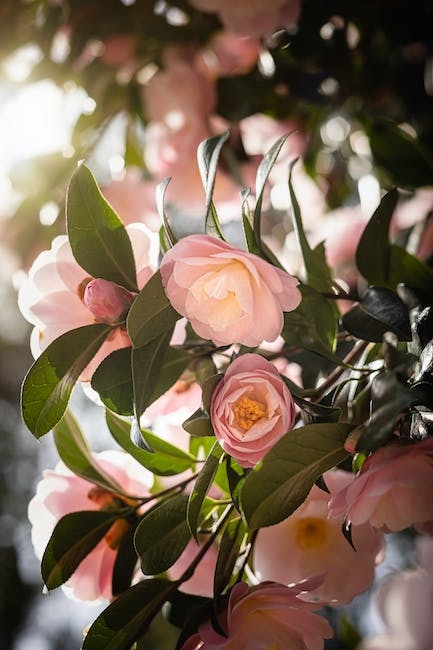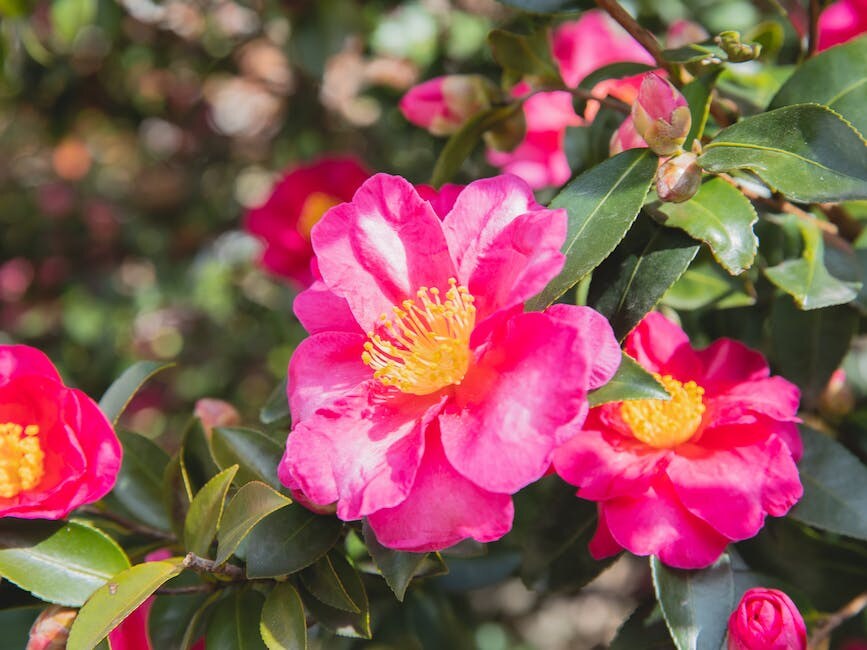Discovering the World of Camellia Sinensis: The Tea Plant
Tea is one of the most widely consumed beverages in the world, and it all starts with the Camellia sinensis plant. This evergreen shrub, native to China, India, and other parts of Asia, is responsible for producing most of the world’s tea. Let’s dive deeper into the fascinating world of Camellia sinensis.
What is Camellia Sinensis?
Camellia sinensis, commonly known as the tea plant, is an evergreen shrub that can grow up to 30 feet tall if left unpruned. However, for tea production, it is usually kept at a much more manageable size. The plant has dark green, glossy leaves that are about 2-4 inches long and are pointed at the end. In the fall, it produces small white flowers, which are followed by small green fruits that contain seeds.
Types of Camellia Sinensis
There are several different varieties of Camellia sinensis, each with its own unique flavor and characteristics. Some of the most common varieties include:
- Assam
- Darjeeling
- Keemun
The flavor and quality of tea produced from Camellia sinensis is affected by a variety of factors, including the climate, soil type, altitude, and harvesting techniques.
Growing Camellia Sinensis
Camellia sinensis is a hardy plant that can tolerate a wide range of growing conditions, although it prefers acidic soil and moderate temperatures. To grow Camellia sinensis, cuttings are often taken from mature plants and rooted in a well-draining soil mix. The plants are then grown in a greenhouse or other protected environment until they are large enough to be transplanted to their permanent location.
The Art of Tea Production
Tea production is a complex process that involves several steps, including withering, rolling, oxidizing, and drying. The quality of the tea produced depends on the skill of the tea maker, as well as the quality of the tea leaves themselves.
The Health Benefits of Tea
Tea is not only a delicious beverage, but it also has several health benefits. It is a rich source of antioxidants, which can help protect against cancer and other diseases. Tea has also been shown to improve brain function, boost metabolism, and aid in weight loss.
Conclusion
Camellia sinensis is a fascinating plant that has been cultivated for centuries for its tea-producing qualities. With its wide range of varieties and growing conditions, there is a tea out there for everyone. So the next time you enjoy a cup of tea, take a moment to appreciate the complex journey that it took to get to your cup.
How to Propagate Camellia Sinensis Cuttings: A Comprehensive Guide
If you’re a tea lover, you’re probably familiar with Camellia Sinensis. This plant is the source of all types of tea, from green to black, and even white tea. But did you know that you can grow your own Camellia Sinensis plant? Yes, you read that right! You can propagate Camellia Sinensis cuttings and grow your own tea plant. In this blog post, we’ll guide you through the process of propagating Camellia Sinensis cuttings.
When to Take Cuttings
The first step in propagating Camellia Sinensis cuttings is to know when to take them. Camellia Sinensis cuttings can be propagated through both softwood and hardwood cuttings. Softwood cuttings are taken in late spring or early summer when the new growth is still flexible and green. Hardwood cuttings, on the other hand, are taken in late fall or winter when the plant is dormant.
How to Take Cuttings
Once you’ve determined the type of cutting you want to take, it’s time to start the propagation process. Here are the steps you need to follow:
- Take a cutting that is 4-6 inches long and has 2-3 leaves attached.
- Remove the lower set of leaves.
- Dip the cut end in rooting hormone powder.
- Plant the cutting in a pot filled with well-draining soil mix and water it thoroughly.
- Cover the pot with a plastic bag or place it in a propagator to maintain humidity and warmth.
- Check the soil regularly and water when it feels dry to the touch.
- After 4-6 weeks, gently tug on the cutting to see if it has rooted. If it resists, it has rooted, and you can remove the plastic cover.
- Transplant the cutting to a larger pot or outside when it has developed a strong root system.
Tips for Success
Here are some additional tips to ensure the success of your Camellia Sinensis cuttings:
- Make sure the soil mix is well-draining to prevent waterlogging, which can lead to root rot.
- Choose a pot that is the right size for the cutting. Too small of a pot can stunt growth, while too large of a pot can cause the soil to stay too wet.
- Keep the cutting out of direct sunlight to prevent it from getting too hot and drying out.
- Use a misting bottle to keep the leaves moist and prevent them from drying out.
- Be patient. It can take several months for the cutting to develop a strong root system and start growing.
Now that you know how to propagate Camellia Sinensis cuttings, it’s time to give it a try! Growing your own tea plant can be a rewarding experience, and you’ll have the satisfaction of knowing that you grew the tea leaves that you’re drinking. Happy propagating!
5 Reasons Why You Should Grow Your Own Camellia Sinensis
Tea is the second most consumed beverage in the world, after water. It is not only delicious but also has various health benefits. However, buying tea can be expensive, and commercially produced tea may not be as flavorful or sustainable as you would like. So, why not grow your own camellia sinensis? Here are 5 reasons why you should:

1. Flavor
When you grow your own camellia sinensis, you can have a fresher and more flavorful tea. Tea leaves are at their best when they are freshly harvested and processed. Commercially produced tea may have been sitting on the shelf for months, losing some of its flavor and aroma. But, when you grow your own tea, you can harvest the leaves at their peak and enjoy a more flavorful cup.
2. Sustainability
Tea production can have negative impacts on the environment, such as deforestation, pesticide use, and water pollution. By growing your own camellia sinensis, you can contribute to sustainability efforts. You can control and reduce these impacts by using organic methods and avoiding harmful chemicals.
3. Cost-effectiveness
Buying tea can be expensive, especially if you are a frequent tea drinker. Growing your own camellia sinensis can be a cost-effective alternative. You only need to purchase the initial cuttings or seeds, and then care for the plant. Over time, you can save money by not having to buy tea.
4. Health benefits
Camellia sinensis is known for its various health benefits, such as improving heart health, reducing inflammation, and boosting brain function. By growing your own tea, you can have access to these benefits in a natural and organic way. Plus, you can control the quality of the tea, ensuring that it is free from harmful chemicals.
5. Educational
Growing your own camellia sinensis can be a fun and educational experience. You can learn about the different varieties of tea, the various processing methods, and the cultural traditions surrounding tea. You can also experiment with different blends and flavors to find your perfect cup of tea.
Conclusion
Growing your own camellia sinensis can be a rewarding and sustainable hobby. You can enjoy a fresher and more flavorful tea, save money, and have access to various health benefits. Plus, you can learn about the rich cultural traditions surrounding tea. So, why not give it a try?
The Art of Growing Camellia Sinensis: Tips and Tricks
If you’re a tea lover, you may have wondered how to grow your own tea plants. Camellia sinensis, the plant from which all tea varieties come from, can be grown at home with the right care and attention. In this blog post, we’ll dive into some tips and tricks to help your camellia sinensis thrive.
Watering
Camellia sinensis cuttings need frequent watering, especially during the first few weeks of planting. However, be cautious not to overwater them. Overwatering can lead to root rot and other fungal diseases. Keep the soil moist but not waterlogged.
Soil and Acidity
The plant prefers well-draining soil that is slightly acidic, with a pH range of 6.0 to 6.5. Adding peat moss or compost to the soil can help improve drainage and increase acidity levels.
Lighting
Camellia sinensis cuttings thrive in partial shade to full sun, but they should not be exposed to direct sunlight for prolonged periods. A location with morning sun and afternoon shade is ideal. If you’re growing the plant indoors, it requires bright, indirect light and a humid environment. A humidifier or misting the leaves regularly can help maintain optimal humidity levels.
Fertilization
Fertilization is important for the growth of camellia sinensis cuttings. A balanced fertilizer with equal amounts of nitrogen, phosphorus, and potassium can be applied once a month during the growing season, from spring to early fall. Avoid fertilizing during the winter months when the plant is dormant.
Pruning
Pruning is also essential for the health and productivity of camellia sinensis cuttings. Regular pruning helps to promote new growth and maintain the desired shape of the plant. Prune the plant in early spring before the new growth appears.
Conclusion
Growing your own camellia sinensis can be a fun and rewarding experience. With the right care and attention, you can enjoy freshly brewed tea from your own garden. Remember to keep the soil moist but not waterlogged, provide the right amount of light, fertilize during the growing season, and prune regularly. Happy growing!


Leave a Reply